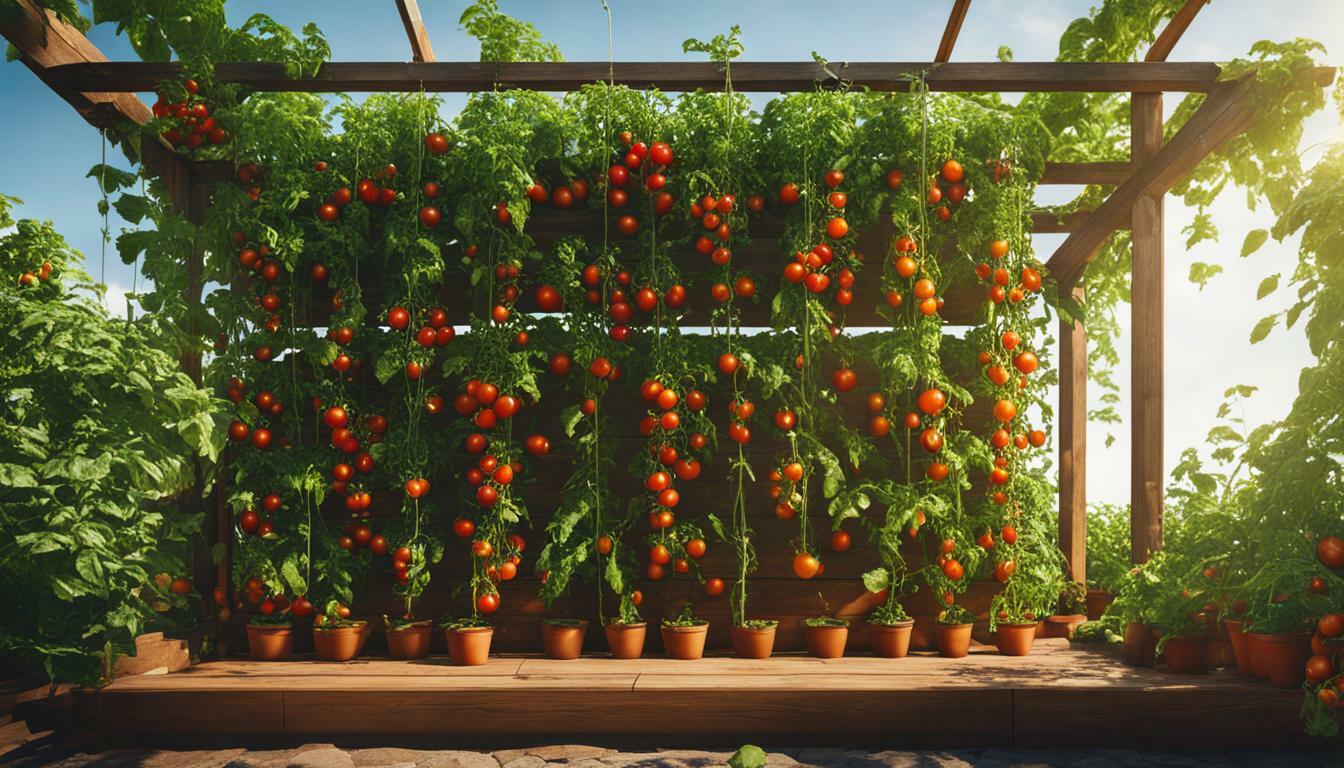Growing tomatoes in a vertical garden can significantly increase your yield and produce output, allowing you to maximize your harvest. By utilizing the vertical space, you can create a thriving tomato garden that not only saves space but also produces healthier crops.
Key Takeaways:
- Growing tomatoes in a vertical garden can maximize your yield and produce output.
- Vertical gardening is a space-saving technique that allows you to grow more tomatoes in a smaller area.
- Proper trellising and pruning techniques are essential for vertical tomato gardening.
- Vertical gardens provide better air circulation, reducing the risk of diseases and pests.
- Both indoor and outdoor vertical gardens can be used to grow tomatoes, with specific considerations for each.
Understanding Tomato Varieties for Vertical Gardening
Before starting your vertical garden for tomatoes, it’s important to understand the difference between vining and bush tomatoes, as well as determinate and indeterminate varieties. Each type of tomato has its own characteristics and requirements, and choosing the right tomato variety for your vertical garden can make a big difference in the success of your crop.
Vining or Bush Tomatoes:
Vining tomatoes, also known as indeterminate tomatoes, are characterized by their long, sprawling vines that continue to grow and produce fruit throughout the growing season. These tomatoes require consistent pruning and support to prevent them from becoming too unruly. Vining tomatoes are ideal for vertical gardening as they can be trained to grow upwards along trellises or stakes, maximizing space and allowing for better air circulation.
On the other hand, bush tomatoes, also known as determinate tomatoes, are compact and bushy in nature, and they stop growing once they reach a certain height. Bush tomatoes are ideal for smaller vertical gardens or containers, as they require less pruning and support compared to vining tomatoes. They are perfect for gardeners who want a concentrated harvest for preservation or canning purposes.
Determinate or Indeterminate Tomatoes:
Determinate tomatoes have a predetermined growth pattern and reach a certain height before setting and ripening their fruit within a shorter period. These tomatoes are great for gardeners who want a more manageable plant size and a concentrated harvest. Determinate tomatoes are recommended for vertical gardens with limited space, as they don’t require as much vertical support.
Indeterminate tomatoes, on the other hand, continue to grow and produce fruit throughout the growing season. These tomatoes require consistent pruning, support, and vertical trellising to manage their vigorous growth. Indeterminate tomatoes are ideal for gardeners who want a continuous harvest of fresh tomatoes throughout the season.
When choosing tomato varieties for vertical gardening, consider the space available, the support structures you plan to use, and your specific gardening goals. Selecting the right tomato varieties will help you make the most of your vertical garden and maximize your yield.
| Vining or Indeterminate Tomatoes | Bush or Determinate Tomatoes |
|---|---|
| Long, sprawling vines | Compact and bushy growth |
| Continue to grow and produce fruit throughout the season | Set and ripen fruit within a shorter period |
| Require consistent pruning and support | Require less pruning and support |
| Ideal for vertical gardening with trellises or stakes | Ideal for smaller vertical gardens or containers |
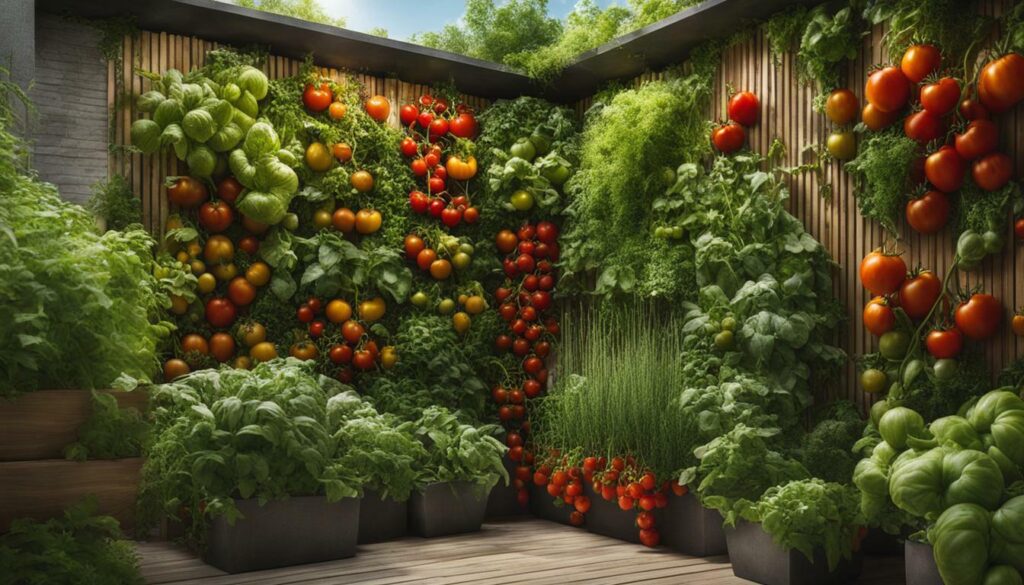
“The right tomato variety can make a big difference in the success of your vertical garden.”
By understanding the characteristics and requirements of vining and bush tomatoes, as well as determinate and indeterminate varieties, you can choose the best tomato plants for your vertical garden. Whether you prefer a continuous harvest of fresh tomatoes or a concentrated harvest for preservation, there is a tomato variety suitable for your vertical gardening needs. Plan your vertical garden accordingly, provide proper support and care, and enjoy the abundance of homegrown tomatoes!
Benefits of Vertical Gardening for Tomatoes
Vertical gardening for tomatoes offers several benefits, including the ability to grow healthier crops and improve air quality in your garden. By utilizing vertical space, you can maximize the yield and productivity of your tomato plants, resulting in a bountiful harvest. Here are some key advantages of vertical gardening for tomatoes:
- Healthier Crops: Growing tomatoes vertically allows for better air circulation around the plants, reducing the chances of fungal diseases and improving overall plant health. The increased airflow helps to minimize moisture on the foliage, preventing the development of common tomato diseases such as blight and mildew.
- Improved Air Quality: Vertical gardening helps to improve air quality in your garden by reducing the density of plants and allowing for better ventilation. This can help to minimize the spread of airborne plant diseases and pests, creating a healthier environment for your tomatoes to thrive.
- Maximize Yield: With vertical gardening, you can grow more tomato plants in a limited space, maximizing your yield and produce output. By utilizing trellises or other vertical structures, you can train the tomato vines to grow upwards, optimizing sunlight exposure and ensuring that each plant receives the necessary nutrients and water for optimal growth.
By harnessing the benefits of vertical gardening, you can create a thriving tomato garden that not only produces an abundance of delicious tomatoes but also enhances the overall health and productivity of your garden.
Table: Vertical Gardening Benefits
| Benefit | Description |
|---|---|
| Healthier Crops | Growing tomatoes vertically improves air circulation, reducing the risk of fungal diseases. |
| Improved Air Quality | Vertical gardening minimizes plant density and enhances ventilation, reducing the spread of diseases and pests. |
| Maximize Yield | Vertical gardening allows for more tomato plants in a limited space, maximizing yield and produce output. |
With these benefits in mind, it’s clear that vertical gardening is a valuable technique for growing tomatoes. Whether you have a small garden or limited space, vertical gardening offers a practical solution for maximizing your tomato harvest and enjoying the many advantages it brings.
Choosing the Right Vertical Garden Design
When it comes to vertical gardening for tomatoes, choosing the right design is crucial for optimizing space and maximizing your yield. The design you choose will depend on various factors such as the type of tomato varieties you plan to grow, the available space, and your personal preferences. Here are some design options to consider:
- Stackable Vertical Planters: Stackable vertical planters are an excellent choice for growing tomatoes in a vertical garden. These planters provide deep pockets for the roots to establish and ample growing space for the plants to thrive. By stacking multiple planters together, you can create a vertical garden system that maximizes your growing area. Plus, they are easy to assemble and maintain, making them suitable for both beginners and experienced gardeners.
- Vertical Trellis: Another popular option for vertical tomato gardening is using a vertical trellis system. This design involves attaching a sturdy trellis or grid to a wall or structure and training the tomato vines to grow vertically along the support. This method allows the plants to take advantage of vertical space while providing them with the necessary support to grow upright. Vertical trellises can be made from materials such as wood, metal, or wire mesh, depending on your preference and budget.
- Vertical Hanging Planters: Vertical hanging planters are a great choice if you have limited space or want to add a decorative element to your vertical garden. These planters can be suspended from hooks or brackets, allowing the tomato plants to cascade downward. They are ideal for growing small or cherry tomato varieties and can be positioned on a balcony, patio, or even indoors near a sunny window. Just make sure to choose planters that have sufficient depth for the tomato roots to grow.
- Vertical Garden Towers: Vertical garden towers are vertical structures with multiple planting pockets that allow you to grow a variety of plants, including tomatoes. These towers provide a compact and space-saving solution for vertical gardening. You can easily rotate the tower to ensure each plant receives adequate sunlight and access for maintenance. Additionally, vertical garden towers often come with built-in irrigation systems, making them convenient and low-maintenance options for growing tomatoes.
When selecting a vertical garden design, consider factors such as the amount of sunlight your chosen location receives, the size of the tomato varieties you want to grow, and the overall aesthetic appeal you are aiming for. Experimenting with different designs can help you find the perfect vertical gardening solution that suits your needs and preferences, ultimately leading to a bountiful tomato harvest.
Trellis Options for Vertical Tomato Gardening
There are several trellis options available for vertical tomato gardening, each with its own advantages and considerations. By providing vertical support, these trellis systems help keep your tomato plants off the ground, protect them from pests and diseases, and promote better air circulation and sunlight exposure. Here are some popular trellis options for growing tomatoes vertically:
1. Stake Fence Support
One option for vertical tomato gardening is using stake fence support. This trellis system involves attaching a piece of wire fencing to a wooden stake. You can adjust the size and width of the trellis based on the height of your tomato plants. As the plants grow, you can use string or cloth strips to tie them to the trellis, keeping the leaves and stems off the ground. Stake fence support is a simple, inexpensive, and effective way to provide vertical support for both bush and vining tomatoes.
2. String Trellising
Another option is string trellising, which is a cost-effective and readily available method. String trellising works well for determinate tomato varieties. For this method, you can create a horizontal string trellis by constructing a frame with wood or metal stakes. Tie strings horizontally across the frame, looping them around each stake in the row. As the tomato plants grow, you can weave new rows of string to provide additional support. Alternatively, you can use vertical hanging trellis, attaching strings above each tomato plant and letting them descend to the ground. Wrap or clip the tomato plants to the strings as they grow.
3. Stake and String Combination
A stake and string combination is another popular trellis option for vertical tomato gardening. This method involves pounding a wooden stake next to each plant and attaching a string to the stake. The string serves as support for the tomato plant, helping it grow vertically. Cedar or metal stakes are commonly used, and jute or sisal strings are recommended for tying the plants to the stakes. This trellis system provides stability and support for indeterminate tomato varieties.
4. Hanging Fence or Netting
If you have indeterminate tomato plants with multiple leaders or heads, a hanging fence or netting can provide the necessary support. Construct a frame that can accommodate tall fencing or netting as per the anticipated height of your plants. As the tomato plants grow, clip, tie, or weave them to the fencing or netting. Use loose loops to avoid constricting the plants as they thickens. This method allows for better airflow and prevents the plants from falling over.
5. Concrete Mesh
Concrete mesh is a durable and relatively inexpensive trellis option for vertical tomato gardening. Made from 9-gauge wire, it is strong enough to support the tomato plants and soft enough to cut without special tools. Concrete mesh is typically used to reinforce concrete in construction projects but can also be repurposed in the garden. It is rust-resistant and can last for years. Simply create a trellis structure with the mesh, allowing the tomato vines to grow and climb on it for support.
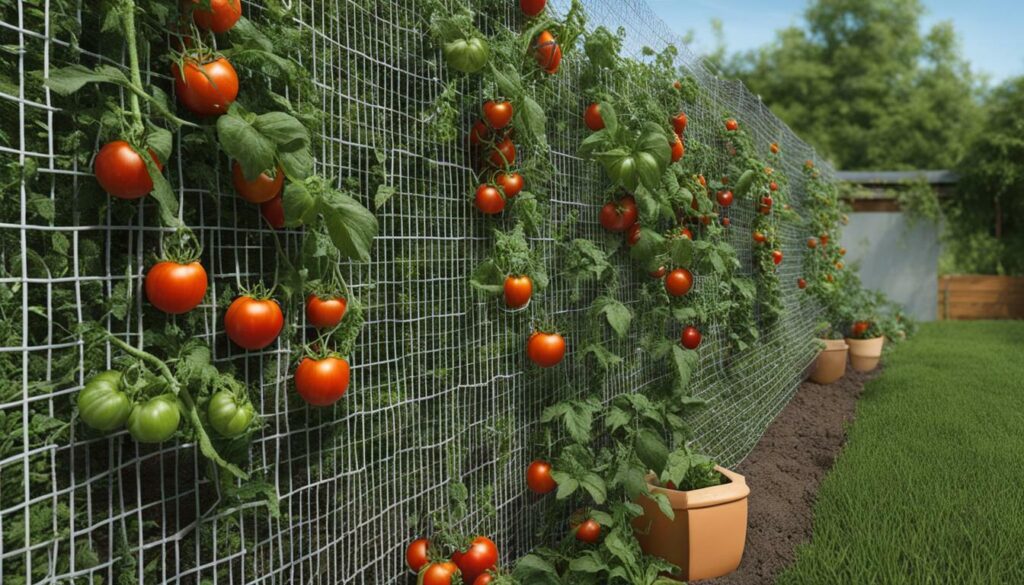
These trellis options provide practical and effective support for your vertical tomato garden, helping your plants grow upright and maximizing space and productivity. Choose the option that best suits your tomato varieties and garden setup, and enjoy a bountiful harvest of delicious homegrown tomatoes.
Tips for Pruning and Training Tomato Vines
Proper pruning and training of tomato vines is essential for successful vertical gardening and maximizing your crop yield. By implementing the right techniques, you can promote healthy growth, maintain proper airflow, and prevent diseases. Here are some tips to help you prune and train your tomato vines in a vertical garden:- Determine the type of tomato variety: Before pruning and training, it’s important to know whether you are growing determinate or indeterminate tomatoes. Determinate varieties grow to a certain height and produce most of their fruit at once. Indeterminate varieties continue to grow and produce fruit throughout the season. Understanding the growth habit of your tomatoes will guide your pruning approach.
- Remove suckers: Suckers are the small, leafy shoots that emerge from the leaf axils of tomato plants. In indeterminate varieties, removing suckers helps redirect the plant’s energy towards producing larger, healthier fruit. For determinate varieties, pruning is generally not necessary as they have a predetermined size and yield.
- Support the main stem: As your tomato plants grow, use stakes, trellises, or cages to support the main stem. This will prevent the plants from toppling over and allow for proper airflow. Make sure to tie the stems gently using soft materials like cloth strips or plant ties to avoid damaging the plants.
- Space the branches: To provide adequate airflow and prevent diseases, space out the branches of your tomato plants. Remove any excess foliage or branches that are closely spaced to reduce the risk of fungal infections and improve sunlight penetration. Aim for a balanced distribution of branches throughout the plant.
- Regularly monitor and adjust: As your tomato plants grow, regularly monitor their progress and make necessary adjustments. This may include tying up new growth to the trellis or pruning additional suckers that emerge. Stay vigilant for signs of pests or diseases and address them promptly to prevent any major damage.
Pruning and Training Tomato Vines Tips in Action
To better understand the process of pruning and training tomato vines, here is an example of how to implement these techniques using the stake and string combination method: 1. Begin by pounding a wooden stake next to each tomato plant when you first plant them in the garden. Make sure to choose sturdy stakes that can withstand the weight of the plants as they grow. 2. As the plants start to grow, gently tie the main stem to the stake, using soft string or plant ties. This will provide support and prevent the plants from leaning or falling over. 3. As the plants continue to grow, regularly check for new suckers that appear in the leaf axils. Carefully remove these suckers by pinching them off with your fingers or using clean pruning shears. Be sure not to damage the main stem or other healthy branches. 4. As the plants reach a mature height, continue to tie any new growth to the stake, ensuring they are properly supported and spaced for optimal airflow. Monitor the plants closely and adjust the ties as needed. By following these steps and adapting them to your specific tomato varieties and growing conditions, you can successfully prune and train your tomato vines in a vertical garden. Remember to always prioritize the health and vigor of the plants, and you’ll be rewarded with a thriving tomato crop.| Benefits of Pruning and Training Tomato Vines in a Vertical Garden: | Methods for Pruning and Training Tomato Vines: |
|---|---|
| – Promotes airflow and reduces the risk of diseases | – Stake and string combination |
| – Increases sunlight penetration for better fruit development | – String trellising |
| – Redirects plant energy towards producing larger, healthier fruit | – Hanging fence or netting |
| – Prevents plants from toppling over and improves space utilization | – Concrete mesh |
| – Allows for easier access to plants for pruning and maintenance | – Alternative support systems |
“Pruning is not just about getting rid of unwanted growth; it’s about shaping the plant to optimize its growth and fruit production.” – Gardening expert
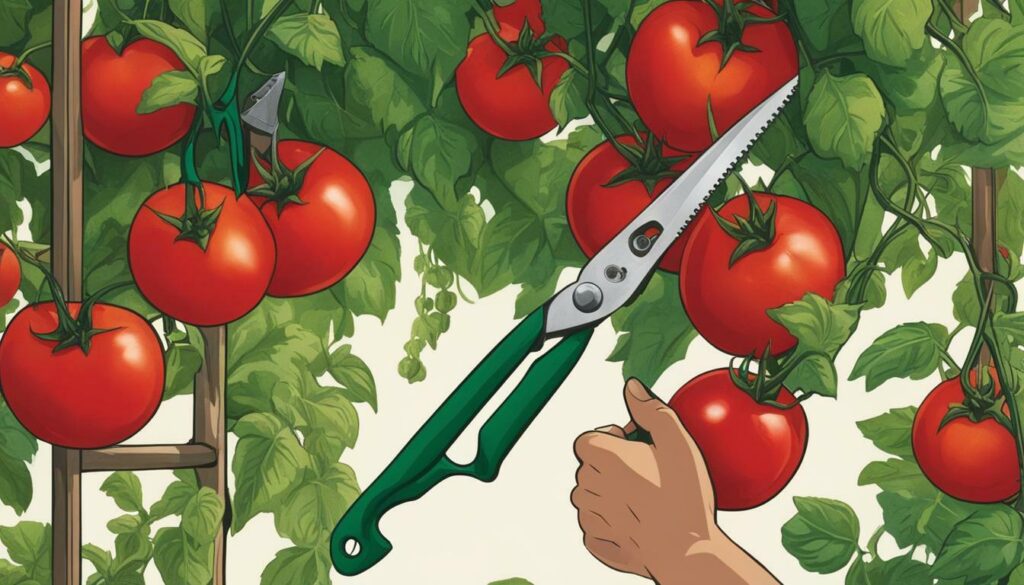 Note: The information provided here is intended as a general guide. It’s always recommended to consult specific pruning and training techniques for the tomato varieties you are growing and adjust accordingly based on your specific growing conditions.
Note: The information provided here is intended as a general guide. It’s always recommended to consult specific pruning and training techniques for the tomato varieties you are growing and adjust accordingly based on your specific growing conditions.Growing Tomatoes in Indoor Vertical Gardens
Indoor vertical gardens provide a unique opportunity for growing tomatoes year-round, but certain factors need to be accounted for to ensure successful growth. Tomatoes are sun-loving plants that thrive in warm temperatures, so it is essential to provide them with adequate light and temperature conditions. Additionally, choosing the right container size and suitable tomato varieties is crucial for indoor tomato gardening.
Lighting and Temperature
Tomatoes require at least 6 to 8 hours of direct sunlight each day to thrive. If you are growing tomatoes indoors, it is important to place them in a location that receives ample sunlight. If natural sunlight is limited, you can supplement it with artificial grow lights. LED grow lights are an excellent option for providing the necessary light spectrum for photosynthesis. Be sure to adjust the distance between the plants and the lights according to the manufacturer’s recommendations to prevent burning or stunting the growth of your tomato plants.
In addition to proper lighting, maintaining a suitable temperature is vital for indoor tomato gardening. Tomato plants thrive at temperatures between 65 to 80 degrees Fahrenheit (18 to 27 degrees Celsius). Keep in mind that extreme temperature fluctuations can stress the plants and affect their growth and fruit production. Therefore, it is important to maintain a stable temperature in the growing area.
Container Size and Tomato Varieties
When selecting containers for indoor tomato gardening, choose pots that are at least 12 to 16 inches deep to accommodate the tomato plants’ deep root systems. Ensure that the pots have adequate drainage holes to prevent waterlogging, which can lead to root rot. It is also essential to provide enough space between each tomato plant to allow for proper air circulation as they grow larger.
For indoor tomato gardening, choose tomato varieties that are well-suited for container growth and have a compact growth habit. Determinate or bush varieties are ideal as they tend to stay more compact and produce fruit within a shorter period. Some popular tomato varieties for indoor gardening include ‘Celebrity,’ ‘Patio Princess,’ and ‘Tiny Tim.’ These varieties are known for their excellent performance in containers and small spaces.
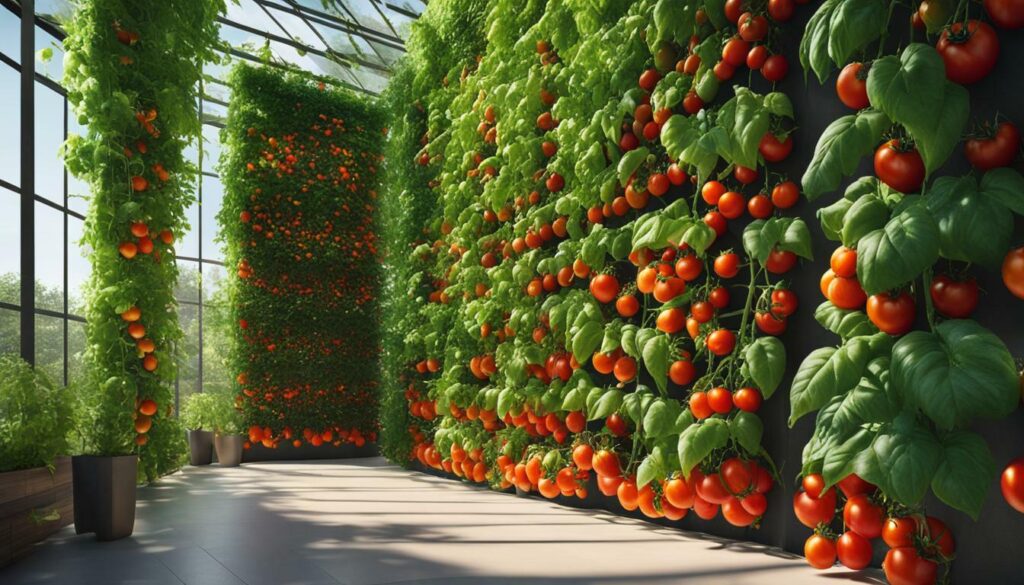
Maintenance and Care
Proper maintenance and care are crucial for the success of your indoor vertical tomato garden. Regularly monitor and adjust the watering to keep the soil evenly moist, avoiding both underwatering and overwatering. Fertilize the plants regularly with a balanced tomato fertilizer to provide them with essential nutrients. Keep a close eye on pest infestations and take prompt action if any pests are detected. Pruning and training the tomato vines are also important to promote proper growth and maximize yield.
By following these guidelines and providing the right conditions, you can enjoy a bountiful harvest of fresh tomatoes from your indoor vertical garden throughout the year. With careful planning and attention to detail, indoor tomato gardening can be a rewarding and productive experience.
Growing Tomatoes in Outdoor Vertical Gardens
Outdoor vertical gardens offer a natural and spacious environment for growing tomatoes, but proper care and attention are still necessary for a successful harvest. Tomatoes thrive in direct sunlight, so it is important to choose a sunny location for your vertical garden. Aim for at least 6 to 8 hours of sunlight per day to ensure optimal growth and fruit production.
In terms of vertical garden methods, stacked planters are the best option for growing tomatoes. Look for planters that offer a depth of at least 8 inches and a width of 8 inches to provide ample space for the plants’ root systems. This kind of planter allows the tomatoes to grow vertically while providing the necessary support and rooting space.
When it comes to choosing the right tomato varieties for your vertical garden, indeterminate varieties are the most suitable. These tomatoes grow in vines and can be easily trained to grow upright. Cherry tomatoes, such as Early Cascade, Sweet Million, and Supersonic, are excellent choices for vertical gardening. Remember not to overcrowd the planter; leave enough space between each plant to ensure proper air circulation and growth.
Regular maintenance is crucial for the success of your tomatoes in an outdoor vertical garden. Water the plants consistently, keeping the soil moist but not waterlogged. Fertilize regularly with a balanced fertilizer to provide the necessary nutrients. Keep an eye out for pests and diseases, such as aphids or tomato blight, and take prompt action to control them. Prune the tomatoes regularly to promote airflow and remove any diseased or damaged leaves.
Overall, with the right location, vertical garden method, tomato varieties, and proper care, you can enjoy a bountiful harvest of delicious homegrown tomatoes from your outdoor vertical garden.
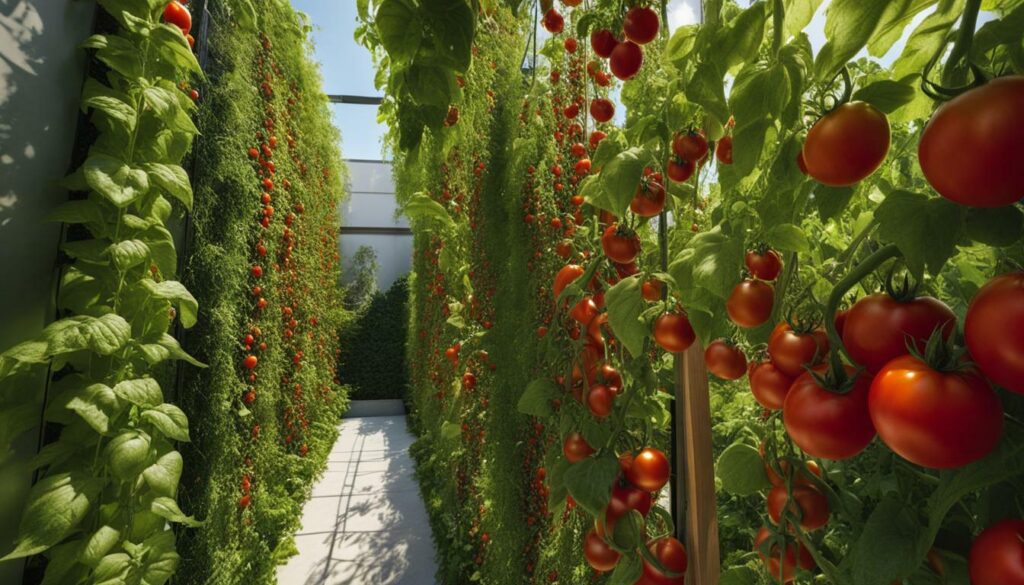
Maintenance and Care Tips for Vertical Tomato Gardens
Maintaining a healthy and thriving vertical tomato garden requires proper care and attention throughout the growing season. By following a few key maintenance and care tips, you can ensure that your plants stay healthy, produce a bountiful crop, and maximize your yield. Here are some essential tips to keep in mind:
- Watering: Tomatoes require consistent and adequate watering to thrive. Check the moisture level of the soil regularly and water deeply to ensure the roots receive enough moisture. Avoid overhead watering to prevent diseases. Consider using a drip irrigation system or a soaker hose for efficient and targeted watering.
- Fertilizing: Provide your vertical tomato plants with regular fertilization to ensure they receive the nutrients they need. Use a balanced, slow-release fertilizer or organic compost to supply a steady source of nutrients throughout the growing season. Follow the manufacturer’s instructions for application rates and timing.
- Pest Control: Regularly monitor your plants for signs of pests such as aphids, whiteflies, or tomato hornworms. If you notice any pests, take prompt action to control them. Use organic pest control methods whenever possible, such as handpicking insects or using insecticidal soap. Consider companion planting with herbs like basil and marigold to help deter pests.
- Pruning and Training: Proper pruning and training are crucial for vertical tomato plants. As the plants grow, remove any suckers that develop in the leaf axils to focus the plant’s energy on fruit production. Use trellises, stakes, or string supports to train the vines and keep them upright. This helps improve air circulation, reduces disease risk, and ensures the plants receive adequate sunlight.
- Weed Control: Keep the area around your vertical tomato garden free from weeds. Weeds compete with your plants for nutrients, water, and sunlight. Regularly remove any weeds that sprout near your plants to prevent them from stealing vital resources.
By following these maintenance and care tips, you can help your vertical tomato garden thrive and maximize your yield. Remember to regularly inspect your plants for any signs of stress or disease and take prompt action to address any issues that arise. With proper care and attention, you’ll be rewarded with a bountiful harvest of delicious tomatoes that you can enjoy throughout the growing season.
Summary
Maintaining a healthy and productive vertical tomato garden requires proper care and attention. Follow these essential tips for watering, fertilizing, pest control, pruning, training, and weed control to ensure your plants thrive. Regularly monitor your plants for signs of stress or disease and take prompt action to address any issues. With the right care, you’ll be rewarded with a bountiful harvest of delicious tomatoes from your vertical garden.
| Care Tips | Key Points |
|---|---|
| Watering | Consistent and deep watering is essential |
| Fertilizing | Provide regular and balanced fertilization |
| Pest Control | Monitor for pests and use organic methods of control |
| Pruning and Training | Proper pruning and training keep plants healthy and productive |
| Weed Control | Keep the area around the garden free from weeds |
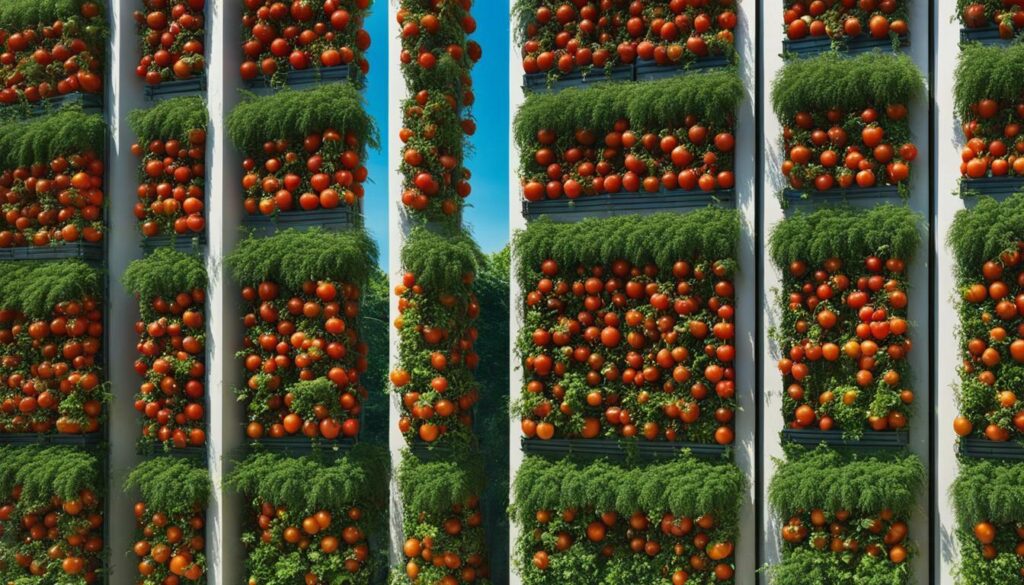
Harvesting and Enjoying Your Vertical Tomato Crop
Harvesting your vertical tomato crop at the right time and enjoying the fruits of your labor is a rewarding experience for any gardener. When it comes to harvesting tomatoes, timing is crucial. You want to wait until the tomatoes are fully ripe for the best flavor and texture. So, how do you know when it’s the right time to harvest?
One way to determine if your tomatoes are ready for harvest is to check their color. Depending on the variety, ripe tomatoes usually have a deep, vibrant color. For red tomatoes, they should be a rich, fiery red when fully ripe. However, there are also varieties that ripen to yellow, orange, or even purple colors. Refer to the specific variety information to identify the ideal color for harvesting.
A gentle squeeze is another method to determine the ripeness of your tomatoes. Ripe tomatoes should be slightly soft to the touch but not too squishy. If they feel too firm, they may need more time to ripen on the vine. On the other hand, if they feel overly soft or mushy, they may be overripe or even starting to rot.
Table 1: Harvesting Guide for Popular Tomato Varieties
| Tomato Variety | Color at Harvest | Texture and Firmness |
|---|---|---|
| Beefsteak | Deep Red | Soft, but not mushy |
| Roma | Bright Red | Firm, but not hard |
| Cherry | Red, Orange, or Yellow | Tender and juicy |
Once you’ve determined that your tomatoes are ready for harvest, it’s time to pick them from the vine. Gently twist and pull the tomato from the stem, taking care to avoid damaging the vine or other nearby fruits. If the stem doesn’t easily detach, you can use a pair of gardening shears or scissors to cut it.
After harvesting your tomatoes, it’s important to store them properly to maintain their quality. If you’re not planning to use them right away, store them at room temperature to allow them to fully ripen. Avoid storing tomatoes in the refrigerator, as it can affect their flavor and texture.
Now that you’ve successfully harvested your vertical tomato crop, it’s time to enjoy the fruits of your labor. Fresh tomatoes are delicious in salads, sandwiches, sauces, and more. Get creative and explore different recipes to make the most of your bountiful tomato harvest.
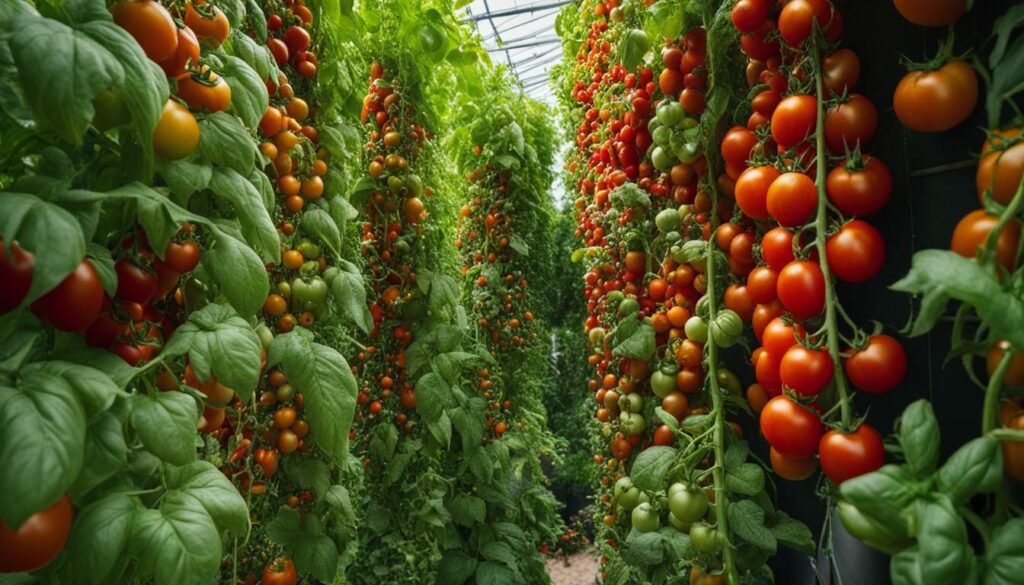
Remember, growing tomatoes in a vertical garden offers many benefits, including maximizing your yield and produce output. With proper care and attention, you can enjoy a plentiful harvest of flavorful, homegrown tomatoes right from your own vertical garden.
Troubleshooting Common Issues in Vertical Tomato Gardening
While vertical tomato gardening offers many benefits, it’s not without its challenges. Understanding and troubleshooting common issues will help you overcome any obstacles in your journey.
One common issue in vertical tomato gardening is inadequate support for the plants. Tomatoes can become heavy as they grow, and without proper support, the vines may collapse under the weight of the fruit. To avoid this, it’s important to choose a sturdy trellis or support system that can withstand the weight of the plants. Consider using stake fence support, string trellising, or a stake and string combination to provide the necessary support for your tomato vines.
Another common issue is insufficient sunlight. Tomatoes require at least six hours of direct sunlight per day to thrive. If your vertical garden is located in a shady area, your plants may not receive enough sunlight, leading to stunted growth and poor fruit production. Consider placing your vertical garden in a sunny spot or using artificial grow lights to supplement the sunlight.
Pest and disease management is also a crucial aspect of vertical tomato gardening. Common pests that affect tomatoes include aphids, whiteflies, and tomato hornworms. Regularly inspect your plants for any signs of infestation and take appropriate measures to control the pests, such as using organic insecticides or introducing beneficial insects. Additionally, be vigilant about common tomato diseases, such as blight and powdery mildew, and promptly address any signs of infection to prevent the spread to other plants.
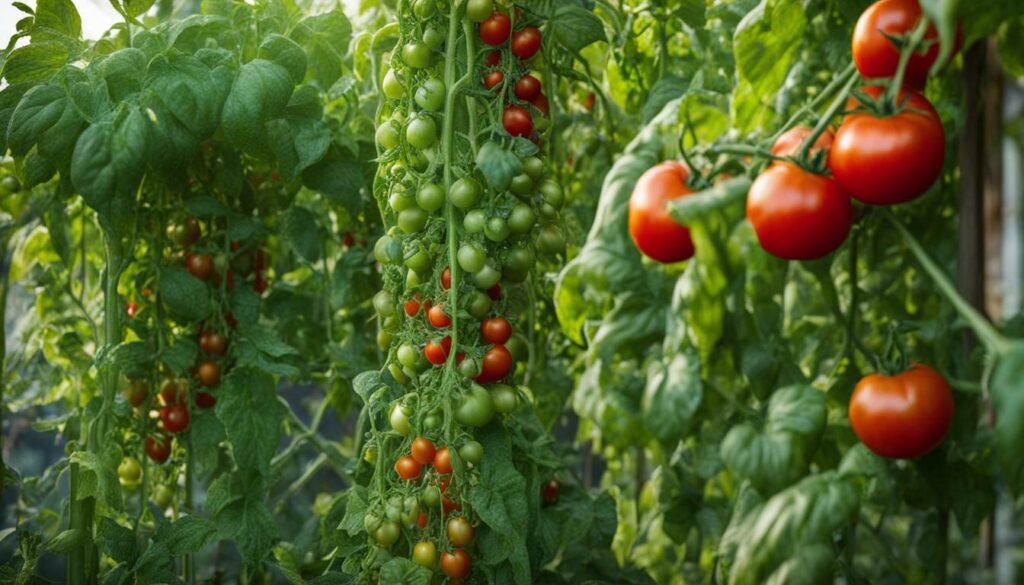
Common Issues in Vertical Tomato Gardening
To summarize, here are some common issues that you may encounter in vertical tomato gardening:
- Inadequate support for the plants
- Insufficient sunlight
- Pest and disease infestation
By being aware of these issues and taking proactive measures to address them, you can ensure the success of your vertical tomato garden. With proper support, ample sunlight, and effective pest and disease management, you’ll be on your way to a bountiful harvest of delicious tomatoes.
Table: Troubleshooting Common Issues in Vertical Tomato Gardening
| Common Issue | Solution |
|---|---|
| Inadequate support for the plants | Choose a sturdy trellis or support system |
| Insufficient sunlight | Place your vertical garden in a sunny spot or use artificial grow lights |
| Pest and disease infestation | Regularly inspect your plants and use appropriate pest control measures |
With these troubleshooting tips in mind, you’ll be well-prepared to tackle any challenges that come your way in vertical tomato gardening. Happy gardening!
Conclusion
Vertical gardening for tomatoes is a highly effective and rewarding method to maximize your yield and enjoy a bountiful harvest in limited space. By utilizing the vertical space, you can grow more tomatoes and increase your produce output. Whether you choose to grow tomatoes in an indoor or outdoor vertical garden, there are several benefits to consider.
Firstly, vertical gardening allows for healthier crops. The proper air circulation and sunlight exposure provided by vertical trellises or supports help reduce the risk of diseases and pests, resulting in healthier plants. Additionally, vertical gardening improves air quality by reducing the likelihood of fungal growth and promoting better overall plant health.
Choosing the right vertical garden design is essential for successful tomato cultivation. Consider factors such as available space, trellis options, and the specific needs of your tomato varieties. Stake fence support, string trellising, and stake and string combinations are popular options to support the growth of tomato vines in a vertical garden.
Pruning and training tomato vines are crucial for optimal growth and higher yield. Regular pruning ensures that the plants focus their energy on fruit production, leading to better-quality tomatoes. It is also important to select tomato varieties suitable for vertical gardening, such as indeterminate types that can grow and fruit continuously throughout the season.
Whether you choose to grow tomatoes in an indoor or outdoor vertical garden, proper care and maintenance are essential for a successful crop. Regular watering, fertilizing, and pest control are necessary to keep your plants healthy and productive. Regular monitoring of your vertical tomato garden will help you identify and address any potential issues before they become major problems.
Once it’s time for harvesting, you can enjoy the fruits of your vertical tomato garden. Harvesting tomatoes at the right time ensures optimal flavor and usage. Be sure to follow proper techniques for harvesting and storing your tomatoes to maintain their freshness and taste.
While vertical tomato gardening offers many benefits, it’s important to be aware of common issues that may arise. Troubleshooting problems such as pest infestations, diseases, and nutrient deficiencies is crucial for maintaining the health and productivity of your vertical tomato garden. With proper care and attention, you can overcome these challenges and enjoy a successful harvest.
In conclusion, vertical gardening for tomatoes is a fantastic way to maximize yield and produce output. By choosing the right tomato varieties, implementing suitable trellis options, and providing proper care and maintenance, you can create a thriving vertical tomato garden and enjoy an abundant harvest year after year.
Can I Use the Vertical Tomato Garden Techniques to Maximize My Tomato Yield?
Yes, you can maximize your tomato yield by using vertical tomato garden tips. By growing your tomatoes vertically, you can save space, reduce the risk of disease, and increase air circulation. Trellising, using cages, or staking are all effective techniques for growing vertically and supporting your tomato plants.
FAQ
Q: What are the benefits of growing tomatoes in a vertical garden?
A: Growing tomatoes in a vertical garden offers benefits such as easier pruning, easier application of fungicides and nutrients, better air circulation, maximum sunlight exposure, and space optimization.
Q: What is the best method for growing tomatoes in a vertical garden?
A: The best method for growing tomatoes in a vertical garden is using stackable planters that provide enough depth for root growth and support for the plants. Inter-cropping with lettuce can also be beneficial.
Q: Where is the best location to grow tomatoes in a vertical garden?
A: Tomatoes in a vertical garden should be planted in a sunny location, as they require 6 to 8 hours of direct sunlight per day.
Q: What tomato varieties are best for vertical gardening?
A: Indeterminate tomato varieties, such as Early Cascade, Sweet Million, and Supersonic, are best for vertical gardening as they can be trained to grow on trellises and continue producing fruit throughout the season.
Q: How do I maintain and care for a vertical tomato garden?
A: Maintenance and care for a vertical tomato garden include proper watering, fertilizing, pest control, and regular monitoring. Pruning and training the tomato vines are also important for optimal growth and yield.
Q: When and how should I harvest tomatoes from my vertical garden?
A: Tomatoes should be harvested when they are fully ripe and firm. They can be gently plucked from the vine or cut with clean shears. Harvested tomatoes can be enjoyed fresh or used in various culinary dishes.
Q: What are some common issues in vertical tomato gardening and how can I troubleshoot them?
A: Common issues in vertical tomato gardening include pests, diseases, and nutrient deficiencies. Proper pest management, disease prevention, and regular monitoring can help address these issues. Nutrient deficiencies can be resolved through proper fertilization and soil amendments.

